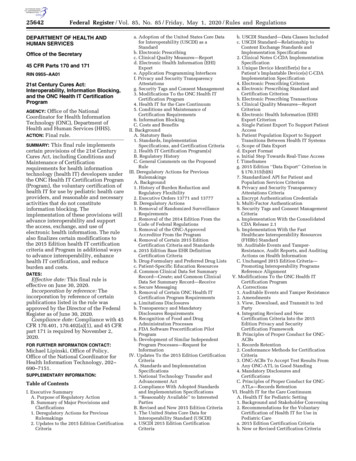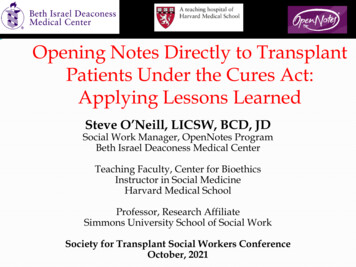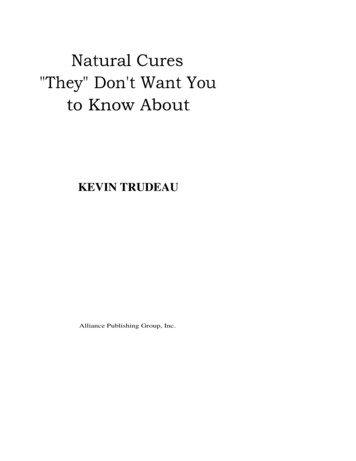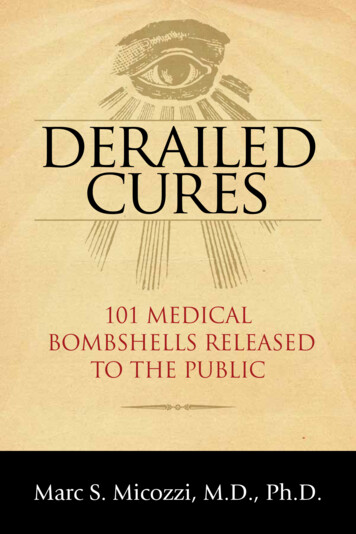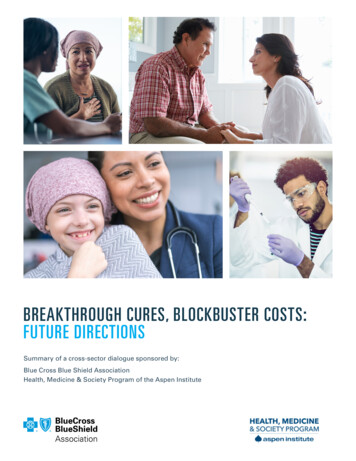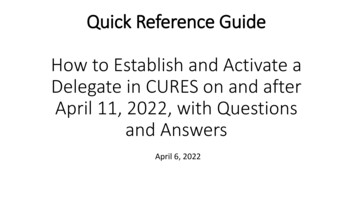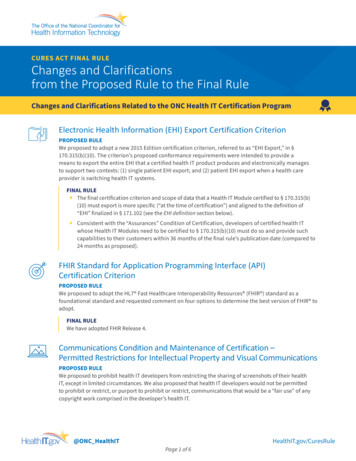
Transcription
CURES ACT FINAL RULEChanges and Clarificationsfrom the Proposed Rule to the Final RuleChanges and Clarifications Related to the ONC Health IT Certification ProgramElectronic Health Information (EHI) Export Certification CriterionPROPOSED RULEWe proposed to adopt a new 2015 Edition certification criterion, referred to as “EHI Export,” in §170.315(b)(10). The criterion’s proposed conformance requirements were intended to provide ameans to export the entire EHI that a certified health IT product produces and electronically managesto support two contexts: (1) single patient EHI export; and (2) patient EHI export when a health careprovider is switching health IT systems.FINAL RULEThe final certification criterion and scope of data that a Health IT Module certified to § 170.315(b)(10) must export is more specific (“at the time of certification”) and aligned to the definition of“EHI” finalized in § 171.102 (see the EHI definition section below). Consistent with the “Assurances” Condition of Certification, developers of certified health ITwhose Health IT Modules need to be certified to § 170.315(b)(10) must do so and provide suchcapabilities to their customers within 36 months of the final rule’s publication date (compared to24 months as proposed).FHIR Standard for Application Programming Interface (API)Certification CriterionPROPOSED RULEWe proposed to adopt the HL7 Fast Healthcare Interoperability Resources (FHIR ) standard as afoundational standard and requested comment on four options to determine the best version of FHIR toadopt.FINAL RULEWe have adopted FHIR Release 4.Communications Condition and Maintenance of Certification –Permitted Restrictions for Intellectual Property and Visual CommunicationsPROPOSED RULEWe proposed to prohibit health IT developers from restricting the sharing of screenshots of their healthIT, except in limited circumstances. We also proposed that health IT developers would not be permittedto prohibit or restrict, or purport to prohibit or restrict, communications that would be a “fair use” of anycopyright work comprised in the developer’s health IT.@ONC HealthITPage 1 of 6HealthIT.gov/CuresRule
Changes and Clarifications from theProposed Rule to the Final RuleChanges and Clarifications Related to the ONC Health IT Certification ProgramFINAL RULEWe clarified in the final rule that screenshots are only one form of visual communications protectedunder the Cures Act, and that the protections afforded to screenshots in the CommunicationsCondition of Certification extend to video. Such visual communications are critical to addressingissues with health IT related to patient safety, usability, security, and interoperability. Developers may, under the permitted prohibitions and restrictions section of the condition, restrictcommunications that involve intellectual property, provided that -» Any prohibition or restriction imposed by a developer must be no broader than necessary toprotect the developer’s intellectual property; and » Are consistent with the other requirements of this section.Developers must not restrict or preclude a public display of a portion of a work subject to copyrightprotection (without regard to whether the copyright is registered) that would reasonablyconstitute a “fair use” of that work.Developers may limit the sharing of screenshots and video of their health IT products to onlythe relevant number of screenshots and amount of video needed to communicate about thecertified health IT products regarding one or more of the six protected subject areas identified inthe 21st Century Cures Act. Developers may limit the sharing of videos to only those videos thataddress temporal matters that cannot be communicated through screenshots or other forms ofcommunication.Changes and Clarifications Related to Information BlockingCompliance TimelinePROPOSED RULEThe information blocking provision did not specify any delays in implementation once finalized.FINAL RULEHealth care providers, health IT developers of certified health IT, health information exchanges, andhealth information networks (“actors”) do not have to comply with the information blocking provisionuntil six months after publication of the final rule. ONC and OIG are also coordinating timing of thecompliance date and the start of information blocking enforcement. Enforcement of informationblocking civil monetary penalties (CMPs) in section 3022(b)(2)(A) of the PHSA will not begin untilestablished by future notice and comment rulemaking by OIG. As a result, actors would not be subjectto penalties until CMP rules are final. At a minimum, the timeframe for enforcement would not beginsooner than the compliance date of the ONC final rule and will depend on when the CMP rules arefinal. Discretion will be exercised such that conduct that occurs before that time will not be subject toinformation blocking CMPs.@ONC HealthITPage 2 of 6HealthIT.gov/CuresRule
Changes and Clarifications from theProposed Rule to the Final RuleChanges and Clarifications Related to Information BlockingEHI DefinitionPROPOSED RULEThe information blocking provision applies to “EHI,” which is not defined in the Cures Act. We proposed abroad definition of EHI in the proposed rule.FINAL RULEWe focused the scope of EHI in § 171.102 in the final rule to mean electronic protected healthinformation (ePHI) as the term is defined for HIPAA in 45 CFR 160.103 to the extent that it would beincluded in a designated record set as defined in 45 CFR 164.501 (other than psychotherapy notesas defined in 45 CFR 164.501 or information compiled in reasonable anticipation of, or for use in, acivil, criminal, or administrative action or proceeding), regardless of whether the group of recordsare used or maintained by or for a covered entity as defined in 45 CFR 160.103. We also clarify that until 24 months after the publication date of the final rule, EHI for purposesof the information blocking definition is limited to the EHI identified by the data elementsrepresented in the USCDI standard adopted in § 170.213.Access, Exchange, and Use DefinitionsFINAL RULEWe clarified the definitions of access, exchange, and use in the final rule. For example, we finalized“use” to mean the ability for EHI, once accessed or exchanged, to be understood and acted upon. Wealso emphasized that “transmitted” within the definition of “exchange” is not limited to a one-waytransmission, but instead is inclusive of all transmissions.What it Means to “Interfere with” Access, Exchange, or Use of EHIFINAL RULEProvided certain criteria are met, we clarified in the final rule that it would not be considered an“interference with” the access, exchange, or use of EHI (and thus not “information blocking”) if aninformation blocking “actor” engaged in practices to educate patients about the privacy and securityrisks posed by the apps they choose to receive their EHI. For example, actors may establish processes where they notify a patient, call to a patient’sattention, or display in advance (as part of the app authorization process with certified APItechnology) whether the third-party developer of the app that the patient is about to authorizeto receive their EHI has attested in the positive or negative as to whether the third party’s privacypolicy and practices (including security practices) meet certain “best practices” set by the marketfor privacy policies and practices.We recommended that the privacy policies and practices of third-party apps should, at a minimum,adhere to the following:» The privacy policy is made publicly accessible at all times, including updated versions;» The privacy policy is shared with all individuals that use the technology prior to thetechnology’s receipt of EHI from an actor;» The privacy policy is written in plain language and in a manner calculated to inform theindividual who uses the technology;@ONC HealthITPage 3 of 6HealthIT.gov/CuresRule
Changes and Clarifications from theProposed Rule to the Final RuleChanges and Clarifications Related to Information Blocking» The privacy policy includes a statement of whether and how the individual’s EHI may beaccessed, exchanged, or used by any other person or other entity, including whether theindividual’s EHI may be sold at any time (including in the future); and» The privacy policy includes a requirement for express consent from the individual before the individual’s EHI is accessed, exchanged, or used, including receiving the individual’sexpress consent before the individual’s EHI is sold (other than disclosures required by law ordisclosures necessary in connection with the sale of the application or a similar transaction).We clarified in the final rule that the information blocking provision does not require actors to violatebusiness associate agreements or associated service level agreements. However, we also clarifiedthat such agreements could constitute an interference if used in a discriminatory manner by anactor to limit or prohibit the access, exchange, or use of EHI for treatment purposes that otherwisewould be permitted by the Privacy Rule.Health Information Network (HIN) andHealth Information Exchange (HIE) DefinitionsPROPOSED RULEThe terms “network” and “exchange” are not defined in the Cures Act. ONC proposed functional definitionsfor these “actors” under the information blocking provision that focused on the role of the actors in thehealth information ecosystem.FINAL RULEWe focused the HIN and HIE definitions in four ways:1.Combined the definitions of HIN and HIE to create one functional definition that applies to bothstatutory terms in order to clarify the types of individuals and entities that would be covered.2.Limited the types of actions that would be necessary for an actor to meet the definition of HIN or HIE.3.Revised the definition to specify that to be a HIN or HIE there must be more than two unaffiliatedindividuals or entities besides the HIN/HIE that are enabled to exchange with each other.4.Focused the definition’s scope to be about exchange related to treatment, payment, and health careoperations, as each are defined in the HIPAA Rules.Structure of the ExceptionsPROPOSED RULEWe proposed seven categories of practices that would be exceptions to the information blocking definition.FINAL RULEWe finalized eight information blocking exceptions, including the new Content and Manner Exception(discussed below). We restructured the exceptions into two categories: Exceptions that involve not fulfilling requests to access, exchange, or use EHI; andExceptions that involve procedures for fulfilling requests to access, exchange, or use EHI.@ONC HealthITPage 4 of 6HealthIT.gov/CuresRule
Changes and Clarifications from theProposed Rule to the Final RuleChanges and Clarifications Related to Information BlockingPromoting Privacy ExceptionPROPOSED RULEWe proposed that to qualify for this exception when individual consent or authorization is a precondition toproviding access, exchange, or use of EHI, an actor would need to do all things reasonably necessary withinits control to provide the individual with a meaningful opportunity to provide the consent or authorization.FINAL RULETo qualify for this exception when individual consent or authorization is a precondition to providingaccess, exchange, or use of EHI, an actor must have used reasonable efforts within its control to providethe individual with a consent or authorization form that satisfies all applicable requirements or haveprovided other reasonable assistance with respect to the deficiencies. In effect, this places more of anobligation on the party requesting the EHI and the individual to attempt to satisfy the precondition byproviding a consent or authorization.New Content and Manner ExceptionFINAL RULEThe Content and Manner Exception was not explicitly proposed in the proposed rule though many of itsprinciples were addressed in various ways. This new exception addresses a broad range of comments wereceived about the required content and manner of an actor’s response to a request to access, exchange,or use EHI. Under the exception, it will not be information blocking for an actor to limit the content ofits response to a request to access, exchange, or use EHI or the manner in which it fulfills a request toaccess, exchange, or use EHI, provided certain conditions are met. This exception supports innovationand competition by allowing actors to first attempt to reach and maintain market negotiated terms forthe access, exchange, and, use of EHI. Content Condition establishes the content (EHI) an actor must provide in response to a request toaccess, exchange, or use EHI in order to satisfy the exception.1. Up to 24 months after the publication date of the Cures Act final rule, an actor must respondto a request to access, exchange, or use EHI with, at a minimum, the EHI identified by the dataelements represented in the United States Core Data for Interoperability (USCDI) standard. 2. On and after 24 months after the publication date of the Cures Act final rule, an actor mustrespond to a request to access, exchange, or use EHI with EHI as defined in § 171.102.Manner Condition establishes the manner in which an actor must fulfill a request to access,exchange, or use EHI in order to satisfy this exception.» An actor may need to fulfill a request in an alternative manner when the actor is: Technically unable to fulfill the request in any manner requested; or Cannot reach agreeable terms with the requestor to fulfill the request.» If an actor fulfills a request in an alternative manner, such fulfillment must comply with theorder of priority described in the manner condition and must satisfy the Fees Exception andLicensing Exception, as applicable.@ONC HealthITPage 5 of 6HealthIT.gov/CuresRule
Changes and Clarifications from theProposed Rule to the Final RuleChanges and Clarifications Related to Information BlockingInfeasibility ExceptionFINAL RULEWe restructured the exception to include: » Two new discreet conditions concerning: Uncontrollable events; and Inability to unambiguously segment the requested EHI.» A condition that describes factors that will be considered to determine whether a request is infeasible under the circumstances.We removed the “reasonable alternative” requirement from this exception and repurposed thatconcept in the new Content and Manner Exception (see above). The Content and Manner Exceptionimproves on the “reasonable alternative” requirement in the proposed rule by clarifying actors’obligations for providing access, exchange, or use of EHI in all situations, creating actionabletechnical procedures, and aligning the requirement for providing an alternative with the FeesException and Licensing Exception.Fees Exception – ProfitsFINAL RULEWe reiterated and included in regulation text that actors may charge fees, including fees that resultin a reasonable profit margin, for accessing, exchanging, or using EHI. We also clarified how the FeesException works with the Licensing Exception and Content and Manner Exception.Licensing Intellectual PropertyFINAL RULEWe reiterated and clarified in the final rule that an actor does not need to license its interoperabilityelements if the actor is able to fulfill a request to access, exchange, or use EHI in an alternative mannerwithout licensing its IP (see the Content and Manner Exception discussed above). We also clarified howthe Licensing Exception works with the Fees Exception and Content and Manner Exception.@ONC HealthITPage 6 of 6HealthIT.gov/CuresRule
The terms "network" and "exchange" are not defined in the Cures Act. ONC proposed functional definitions . for these "actors" under the information blocking provision that focused on the role of the actors in the health information ecosystem. FINAL RULE. We focused the HIN and HIE definitions in four ways: 1.

